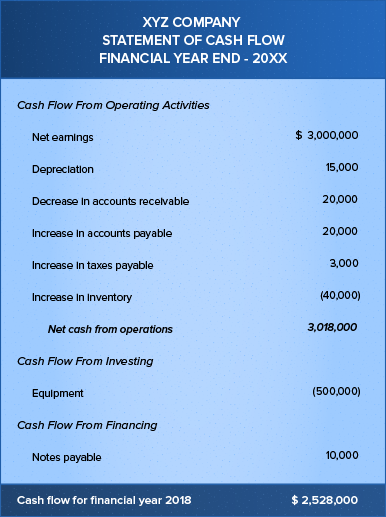Being a business owner, you need not be an expert in accounting to understand your financial statements. But you definitely can in case you wish to be. You can utilize them for making a detailed business decision. A cash flow statement shows how much money your business is profiting and losing.
Alongside income statements and balance sheets, this is one of the three most crucial financial statements for dealing with your business bookkeeping and ensuring you have an adequate amount of cash to keep running business operations.
Table of Contents
What Does Cash Flow Statement Mean?
The Cash Flow Statement adjusts the data on your Balance Sheet and Profit & Loss Statement. It summarizes all the transactions that shift cash out of and into the bank accounts of your business.
To prepare a cash flow statement, accountants or bookkeeping software lists the net income on your Profit & Loss Report and reconcile it. Hence, the new number showcases the actual cash that moved. This statement is also found where selling shares, fundraising, and earning interests on investments get reported by bookkeepers.
Taking all the data, the cash flow statement gives a distinct outlook than other reports can offer. It allows you to adjust and confirm that the digits in your bank account relevantly match your business’s financial activities.
Simultaneously, it offers an idea of the financial position – by seeing transactions that have not occurred yet and representing every income type.
Why is Cash Flow Statement Important?
A business must have enough amounts of cash to be successful. This helps it purchase commodities, repay bank loans, and invest for receiving profitable returns. Here are some reasons why cash flow statements are important:
1. It Helps Keep Up With Optimal Cash Balance
Cash flow statements help to maintain the ultimate cash level on hand. They are essential for organizations to decide whether there is a lack or excess of funds or whether very much of their cash is staying idle. In case there is excess cash lying idle, businesses can utilize it to purchase inventory or investing shares. And if funds are insufficient, companies can seek sources from which they can borrow finances to keep their businesses running.
2. It Provides Details about Spending
Cash flow statements provide transparent insight into the principle payments that the organizations make to their creditors. Moreover, these statements display transactions that are recorded in cash and not seen in other financial statements. These incorporate buys of products for inventory, purchasing capital equipment, and maximizing credit to consumers.
3. It is Helpful for Short-Term Planning
Successful businesses should always have enough liquid cash for meeting short-term accountabilities like future payments. Finance managers can assess both incoming and outgoing cash from earlier transactions for making important decisions. Some situations where determinations must be made depending on the cash flow incorporate predicting cash shortage for repaying debts or setting up a base for requesting credit from banks.
4. It Helps You Concentrate on Producing Cash
Profit plays a pivotal role in the development of an organization by producing cash. However, several other ways are there for producing cash. For example, when an organization discovers a way of paying less for apparatus, it produces cash. Each time it gets receivables from its consumers faster than users, it is obtaining money.
What is an Example of a Cash Flow?
Here is an example of a cash flow statement for XYZ organization at the end of FY (Financial Year) 2018:
What is a Good Cash Flow?
You can consider a positive cash flow as ‘good cash flow.’ When you get a positive number at the bottom of your cash flow statement, you have received a good cash flow for the month.
How do You Prepare a Cash Flow Statement?
1. The Direct Method
It uses actual cash flow data from the operations of the company. It presents the main classes of gross cash payments and receipts. Small businesses possibly use this method by doing their bookkeeping on cash instead of on a profit basis.
2. The Indirect Method
This method draws the data from the changes on the Balance Sheet and the Income Statement. Both the Balance Sheet and Income Statement depends on profit accounting.
What Are the 3 Types of Cash Flows?
The statement of cash flows streamlines and reports cash in 3 sections – Financing, Investing and Operating.
1. Cash Flow from Financing Activities
Long-term borrowings, stock options or loans, changes in debt – these are covered under financing activities. When capital is increased, it is pondered ‘cash in.’ When you reduce debts or dividends are paid, it is considered ‘cash out. In a nutshell, financing activities showcase how borrowing impacts the cash flow of an organization.
2. Cash Flow Investing Activities
This component records all changes in investments, assets, or equipment. Cash transformations from the investment are usually known as ‘cash outflows’ as cash is utilized for buying short-term assets, buildings, or devices. When an organization dispossesses an asset, its transaction is called a ‘cash inflow. A healthy organization usually invests continuously in devices, land, plant, and other fixed components.
3. Cash Flow from Operating Activities
This section represents the primary source of the cash production of a company. This is the most crucial data on the cash flow statement. It displays how much cash you’ve produced from the basic services or products of a company. A positive, healthy cash flow from business operations indicates that it’s a healthy company.
Endnote
The statement of cash flows is essential, as it showcases if a business has sufficient liquid cash for paying off its debts and investing in new assets. You can’t interpret the performance of an organization by merely checking the cash flow statement. You may require assessing long-term trends after referring to the income statement and balance sheet for receiving a clear image of how an organization is managing its finances.




